Casseroles work well in sun-powered ovens because they combine multiple factors that maximize solar cooking efficiency. You'll want to start with pre-cooked ingredients and use dark-colored, thin-walled cookware to absorb heat effectively. Position dense ingredients at the bottom of your dish, and use binding agents like condensed soup or Greek yogurt to maintain moisture. The layered nature of casseroles allows for even heat distribution through conduction and natural convection, while a tight-fitting lid traps heat and moisture. For best results, you'll need to adjust your solar oven every 30-45 minutes to follow the sun. There's more to perfecting your solar casserole technique than meets the eye.
Solar Heat Distribution Principles
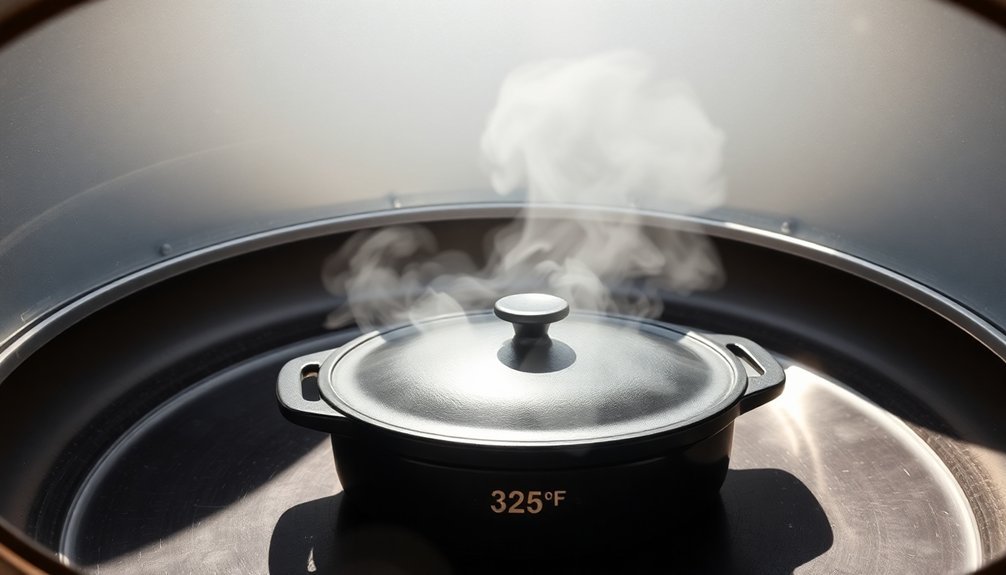
When cooking casseroles in a solar oven, understanding heat distribution is essential for successful results. Your solar oven captures sunlight through the greenhouse effect, where UV rays enter through the glazed surface and convert to heat-trapping infrared rays.
You'll need to position your oven to face the sun directly and adjust it periodically for ideal exposure. Similar to passive solar building design, which can achieve 25-75% energy savings, solar ovens maximize available sunlight for optimal efficiency.
The dark-colored interior and cookware in your solar oven absorb sunlight efficiently, converting it to heat energy. This heat moves through three key mechanisms: conduction transfers heat through your cookware, radiation warms food directly through electromagnetic waves, and natural convection currents circulate hot air throughout the oven.
When these processes work together, they create an even heating environment that's perfect for cooking your casserole thoroughly and consistently.
Preparing Your Casserole Base
A successful solar-cooked casserole starts with a well-planned base of complementary ingredients.
You'll need to select your core components carefully and combine them in a way that guarantees even cooking in your solar oven.
Start with a hearty starch like pasta or rice, then add your chosen protein and vegetables.
- Choose pre-cooked pasta or rice as your foundation
- Mix in cooked ground meat or canned fish for protein
- Add frozen or canned vegetables for moisture and nutrition
- Include a binding agent like condensed soup or Greek yogurt
- Blend in appropriate seasonings and herbs for flavor depth
As you combine these elements, make certain you're creating a consistent mixture that will cook evenly.
The moisture from your vegetables and binding agents will help distribute heat throughout the dish while cooking in your solar oven.
Since 200 degrees Fahrenheit is the typical maximum temperature your solar oven will reach, ensure all ingredients are pre-cooked for food safety.
Equipment and Container Selection
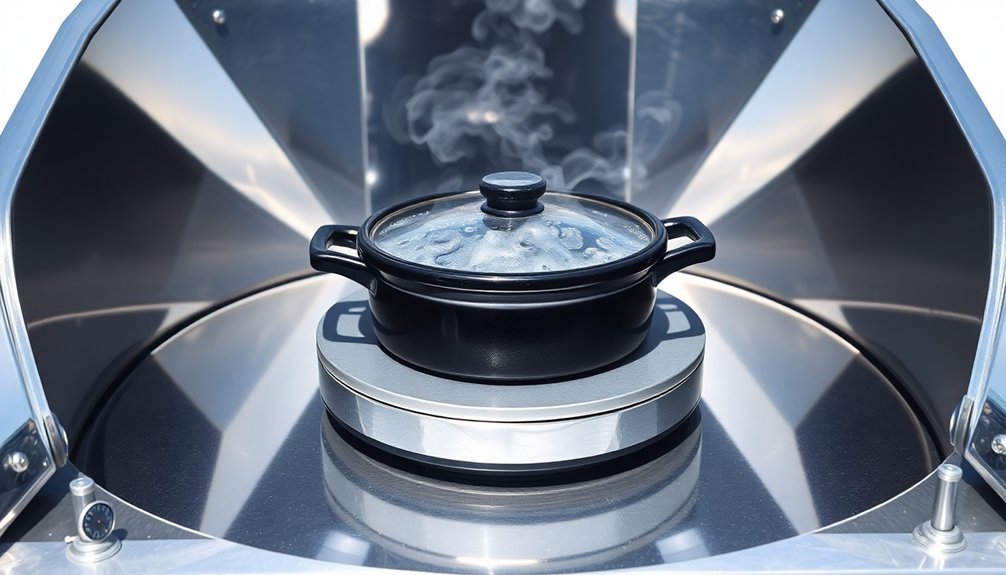
Selecting the right equipment and containers plays a crucial role in successful solar casserole cooking. You'll need a specialized solar oven like the Global Sun Oven or SunFocus, equipped with reflective surfaces and proper insulation to maintain consistent temperatures. The aluminum foil lining helps reflect heat effectively throughout the cooking chamber.
For your casserole container, choose a dark-colored, thin-walled vessel with a lid that fits comfortably in your solar oven. The best container should be made of black enamelled steel or ceramic-lined material to maximize heat absorption.
Make sure it's dishwasher-safe and features non-stick properties for easy cleaning. If you're using a larger solar oven, look for containers that can be stacked to maximize cooking space.
Don't forget to include a thermometer to monitor your cooking temperatures and adjust the oven's angle for optimal sunlight exposure.
Temperature Control Methods
You'll need to maintain ideal cooking temperatures by using a reliable thermometer that can handle 150-225°F and regularly checking your casserole's progress.
Position your solar oven to face the sun directly and adjust it every 30-45 minutes to track the sun's movement for consistent heat exposure.
Stack multiple layers of natural insulation materials like crumpled newspaper around the cooking chamber and top them with aluminum foil to maximize heat retention. A proper setup allows casseroles to achieve temperatures up to 400°F in box-style cookers.
Monitoring Heat With Thermometers
The successful use of solar ovens for casseroles depends heavily on accurate temperature monitoring.
You'll need to track both the oven chamber and your food's internal temperature to guarantee safe, effective cooking. Use an instant-read or probe thermometer to check that your casserole reaches 165°F, and position it in the thickest part without touching the dish's sides or bottom.
- Check temperatures every 10-15 minutes during reheating
- Use oven thermometers to monitor the cooking chamber's heat
- Position thermometers near food, not against container surfaces
- Calibrate your thermometers regularly for reliable readings
- Adjust the solar oven's position to maintain desired temperatures
Regular monitoring helps prevent undercooking or overcooking while guaranteeing food safety.
As sunlight intensity changes throughout the day, you'll need to make positioning adjustments to maintain ideal cooking temperatures.
Positioning For Maximum Exposure
Proper positioning of your solar oven makes all the difference in achieving consistent cooking temperatures for casseroles.
You'll need to face your oven directly toward the sun, adjusting it every 30-45 minutes to track the sun's movement. Use a leg or stand to tilt the oven, ensuring the sun's rays hit evenly with the front.
For maximum heat collection, set up in a wind-sheltered spot with clear exposure during peak hours (10 AM-4 PM).
You'll want to enhance performance by using reflective flaps or panels, keeping them clean and properly angled. Position these surfaces strategically to concentrate sunlight onto your cooking area.
During non-summer months, you'll need to adjust the tilt more frequently to compensate for the sun's lower angle in the sky.
Insulation Layer Best Practices
Effective insulation layers serve as the foundation for maintaining consistent temperatures in your solar oven.
You'll want to surround your cooking cavity with multiple layers of insulating materials that trap air particles. Choose materials like crumpled newspaper, dry leaves, or spun fiberglass to create an efficient thermal barrier.
Don't forget to extend the insulation up to the box rims for even heat distribution.
- Layer your insulation with aluminum foil to keep materials separate from the cooking chamber
- Create an air gap between insulation and cooking surface for better thermal efficiency
- Use locally available materials like sand, soil, or cardboard for cost-effective solutions
- Pack insulation tightly but don't exceed the height difference between nested boxes
- Add thermal mass objects like bricks to maintain heat levels after sunset
Adapting Liquid Ingredients

Successfully adapting liquid ingredients in sun-powered ovens requires careful evaluation of moisture content and cooking dynamics.
You'll need to minimize water usage while maximizing flavor impact. Start by selecting concentrated ingredients like tomato paste or cream-based soups that won't evaporate quickly.
You can maintain moisture by covering your casserole with a lid and using dark, heat-retentive cookware. Instead of adding plain water, opt for flavor-rich liquids like broth or marinades.
Don't forget to take into account the natural juices from vegetables and meats. You'll want to incorporate thickening agents like flour or starch to manage consistency, and keep an eye on your dish throughout cooking.
Add ingredients with high water content, such as potatoes or carrots, to help prevent over-drying while your casserole cooks.
Layering for Maximum Heat Absorption
When you're arranging ingredients in your solar casserole, start with darker ingredients at the bottom of the dish to maximize heat absorption from the sun.
You'll want to spread sauces and ingredients evenly across each layer to guarantee consistent heating throughout the dish.
Building your layers systematically from bottom to top helps create ideal heat distribution and guarantees every portion cooks thoroughly.
Dark Ingredients First
The strategic placement of dark ingredients in your solar casserole can make the difference between a well-cooked meal and an unevenly heated dish.
You'll want to start with dark-colored ingredients at the bottom layer, as they're most efficient at converting sunlight into heat energy. When you're layering your casserole, guarantee complete coverage of the bottom surface to prevent cold spots.
- Use dark sauces or meat mixtures as your foundation layer
- Break up noodles or larger ingredients to create an even surface
- Maximize the exposed area of dark ingredients to sunlight
- Avoid reflective or light-colored ingredients in bottom layers
- Choose dark, thin cookware to enhance heat absorption
Remember that proper layering with dark ingredients helps your solar oven maintain consistent temperatures throughout the cooking process.
Even Heat Distribution Methods
Building upon the dark ingredient foundation, proper layering techniques maximize heat absorption throughout your entire solar casserole.
You'll want to place denser ingredients at the bottom, creating layers that allow the sun's converted heat energy to penetrate evenly through each component.
To achieve ideal results, you'll need dark-colored cookware that effectively absorbs solar energy.
Make sure to use a lid to trap and distribute heat uniformly.
Position your solar oven directly facing the sun and adjust it every 1-2 hours to maintain the best angle.
If it's cloudy, you'll need to start cooking earlier and expect longer cooking times.
Remember that proper insulation is essential – your cookware's cover will prevent heat from escaping, ensuring all layers cook consistently without developing hot spots.
Timing Your Solar Casserole Recipe
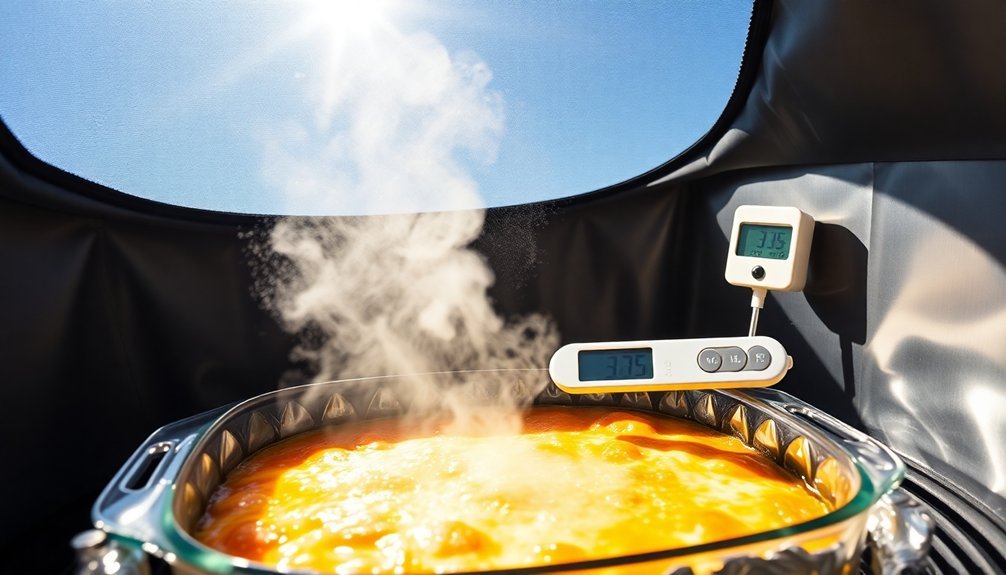
Successfully timing your solar casserole requires understanding several key variables that affect cooking duration.
You'll need 2-4 hours of cooking time between 10 am and 4 pm when the sun's intensity peaks. Preheating your solar oven while preparing ingredients guarantees ideal temperature from the start. For consistent results, position your oven away from wind and potential shade.
- Dark, shallow pots with tight lids cook faster and retain heat better
- Soaking ingredients like beans overnight reduces overall cooking time
- Larger portions and thicker layers need extended cooking periods
- Adjust oven orientation every couple of hours to maintain sun exposure
- Keep the lid on and minimize checking to prevent heat loss
Remember to use an oven thermometer to monitor internal temperature and refocus every 30 minutes when aiming for higher temperatures.
Frequently Asked Questions
Can I Cook Casseroles on Partly Cloudy Winter Days?
Yes, you can cook casseroles on partly cloudy winter days, but you'll need extra time. Adjust your oven's angle, use multiple reflectors, and expect cooking to take several hours longer than usual.
How Do Different Colored Casserole Ingredients Affect Cooking Performance?
The color of your ingredients doesn't greatly impact cooking performance. Instead, focus on your casserole dish's color – dark ones work best by absorbing more solar heat and cooking food more efficiently.
What Happens if Animals or Birds Disturb My Solar Oven?
If animals disturb your solar oven, you'll lose cooking heat and alignment with the sun. To prevent this, secure your oven with weights, use covers when not cooking, and place it away from wildlife areas.
Should Leftovers Be Reheated in a Solar Oven?
You can reheat leftovers safely in a solar oven if you're vigilant about temperature monitoring. Make sure food reaches 165°F, don't leave it in the danger zone too long, and always check for proper heating.
Can I Stack Multiple Casserole Dishes in One Solar Oven?
You shouldn't stack multiple casserole dishes in your solar oven. It'll disrupt heat distribution and slow cooking. For best results, cook one dish at a time or use separate ovens for multiple dishes.
In Summary
You'll find that successful solar oven casseroles rely on proper heat distribution, container choice, and ingredient adjustments. Dark, shallow pans and well-layered ingredients help maximize sun absorption, while monitoring moisture levels prevents your dish from drying out. Remember to allow extra cooking time and check your casserole's internal temperature regularly. With these principles in mind, you're ready to harness solar power for delicious, energy-efficient meals.

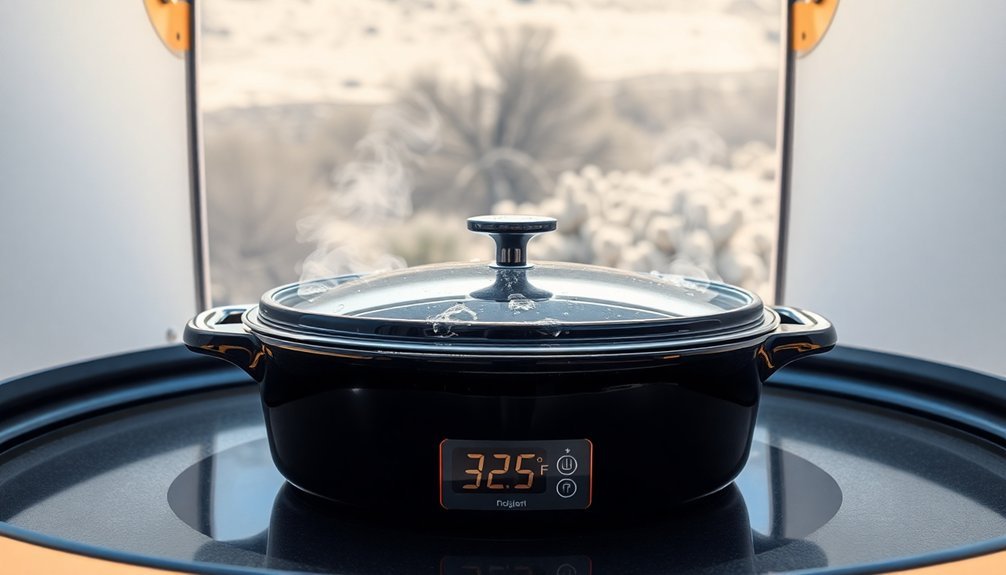

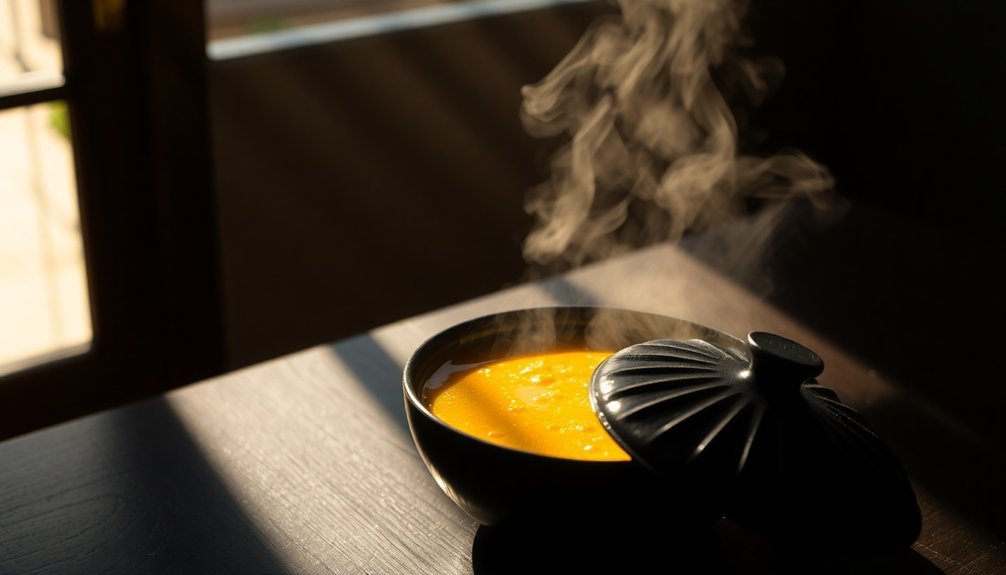
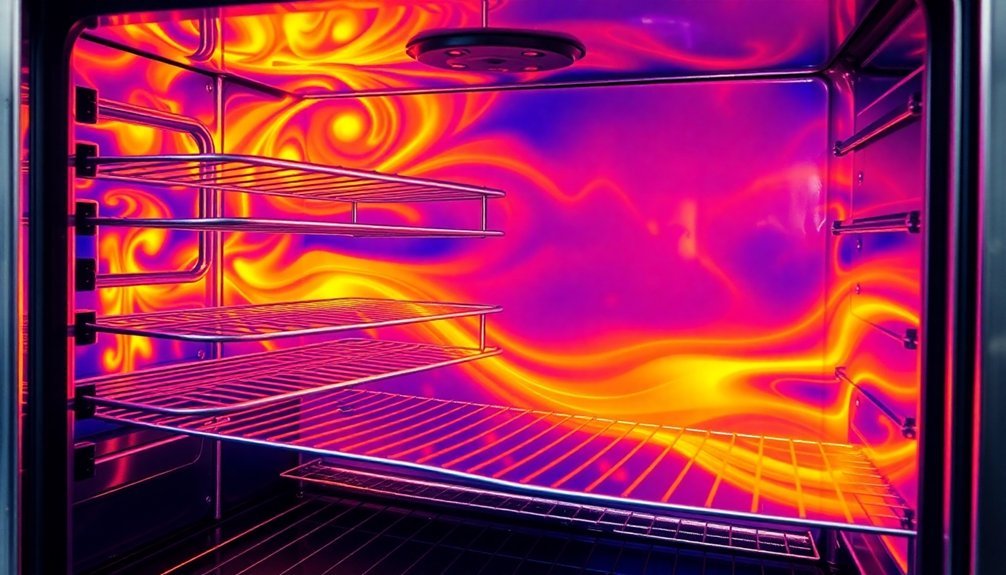
Leave a Reply